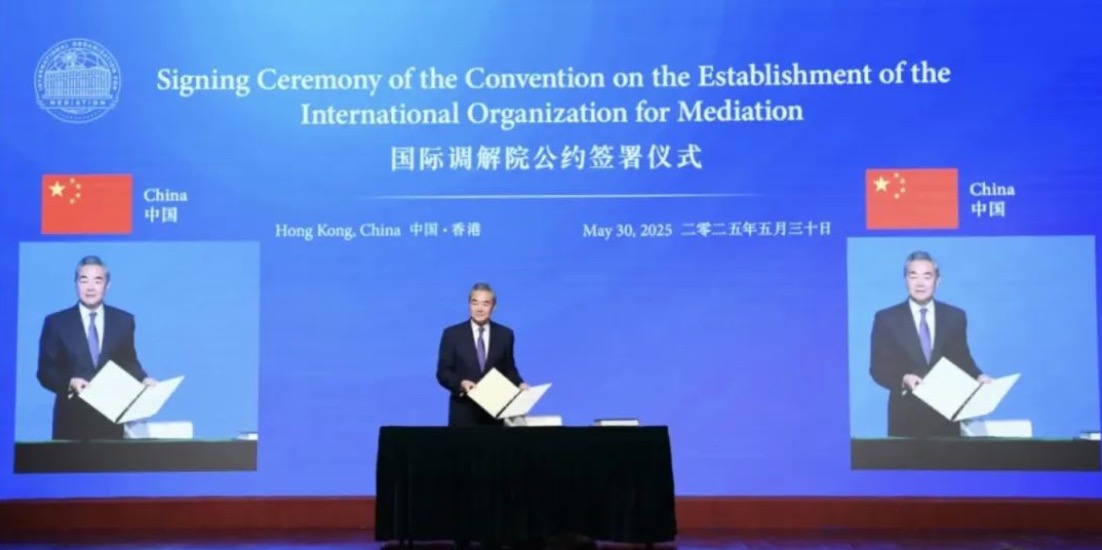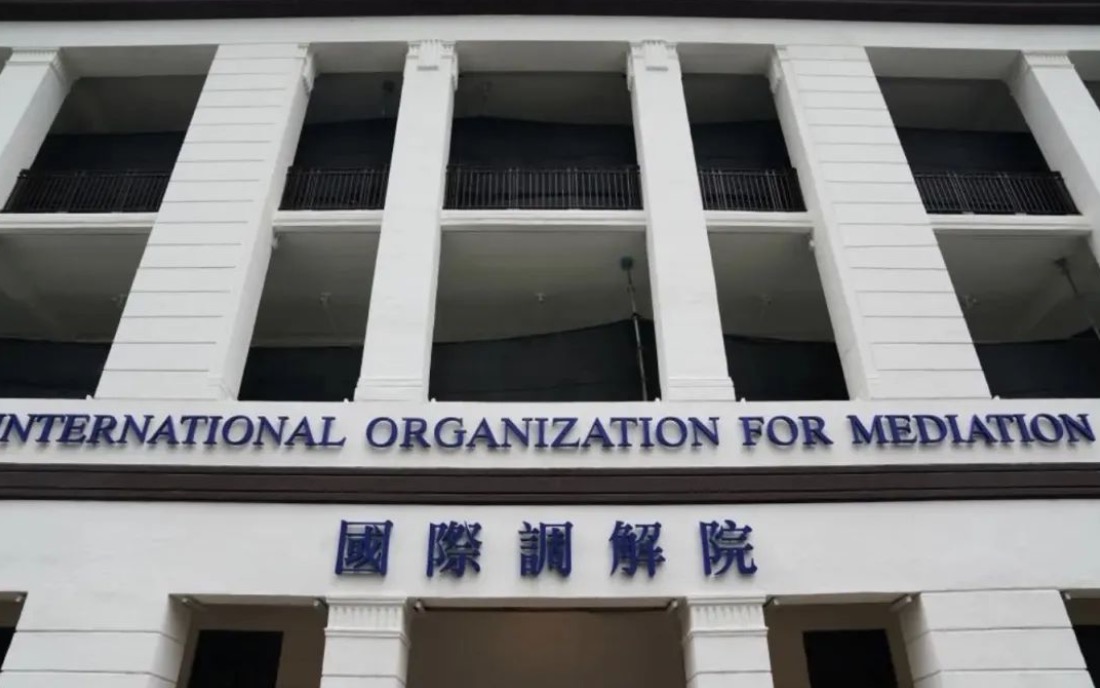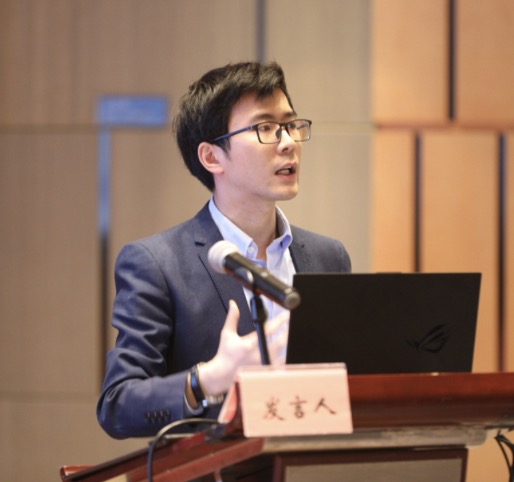On May 30, 2025, 33 countries, including China, signed the Convention on the Establishment of the International Organization for Mediation (hereinafter referred to as the “Convention”)[1] in Hong Kong, China. This marks the realization of the International Organization for Mediation (IOMed), which had been in preparation for over two years. The IOMed is the first international organization dedicated exclusively to resolving international disputes through mediation. As the Chinese Foreign Minister Wang Yi stated, the establishment of the IOMed “will fill an institutional gap in international mediation and serve as an important public good in the field of the rule of law for better global governance.”[2]
Given that disputes between China and the Philippines in certain parts of the South China Sea in recent years have not been properly resolved, with periodic escalations occurring over the past two years, the likelihood of the two countries resolving their disputes through negotiation or judicial means in the short term appears minimal. If both nations could instead explore the implementation of the new IOMed mechanism to settle certain disputes in the South China Sea, it might represent an innovative approach worth considering. The feasibility of this method warrants exploration.

Conciliation: A Traditional International Dispute Resolution Method Evolving with Contemporary Practices
Conciliation is one of the political methods for the peaceful settlement of international disputes stipulated in Article 33 of the UN Charter.[3] It is also explicitly listed as a primary peaceful dispute resolution method in major international instruments including the 1948 American Treaty on Pacific Settlement (Pact of Bogota), the 1957 European Convention for the Peaceful Settlement of Disputes, the 1970 Declaration on Principles of International Law and the 1982 Manila Declaration on the Peaceful Settlement of International Disputes.[4] According to the 1961 Resolution of the Institut de Droit International, conciliation is defined as: “a method for the settlement of international disputes of any nature according to which a commission set up by the parties, either on a permanent basis or on ad hoc basis to deal with a dispute, proceeds to the impartial examination of the dispute and attempts to define the terms of a settlement susceptible of being accepted by them, or of affording the parties, with a view to its settlement, such aid as they may have requested.”[5]
Traditionally, conciliation has been regarded as an intermediary approach between mediation and arbitration/judicial settlement.[6] Compared with mediation, conciliation emphasizes formal institutional proceedings by a conciliation commission, rather than relying on the mediator’s personal initiative. Compared with arbitration or judicial settlement, conciliation grants parties to a dispute greater procedural autonomy and flexibility and the outcomes of a conciliation are more controllable by the disputing parties as its results generally lack the legally binding force characteristic of the arbitral award or judicial decision. In recent years, in both theory and practice, conciliation and mediation have increasingly converged. For instance, the 2018 United Nations Convention on International Settlement Agreements Resulting from Mediation (the Singapore Convention on Mediation) uses “mediation” to encompass conciliation. Sun Jin, Director of the IOMed Preparatory Office, pointed out in a journal article that “[t]he terms ‘conciliation’ and ‘mediation’ are interchangeable; both may be collectively referred to as mediation.”[7] As such, Article 2(1) of the Convention on the Establishment of the International Organization for Mediation defines mediation as: “a process, whether referred to by the term mediation, conciliation or other similar expressions, whereby the parties attempt to reach a mutually acceptable and amicable settlement of their dispute on a voluntary basis with the assistance of a third person or persons (mediator) who may facilitate a solution between the parties to the dispute and lack the power to impose it upon them.” This definition demonstrates that mediation under the Convention represents an evolved approach to international dispute resolution. It integrates features of both traditional conciliation and mediation, and it adapts to contemporary needs while preserving the core facilitative nature of mediation.
The Inter-State Dispute Mediation Mechanism of the IOMed and Its Characteristics
The jurisdictional scope of the IOMed under Chapter V of the Convention encompasses disputes between States, disputes between a State and a national of another State, and international commercial disputes between private parties. For inter-State disputes, the consent of the disputing parties is fully safeguarded throughout the mediation process. Firstly, Articles 24 and 25 of the Convention establish consent as a precondition for initiating mediation. Sun Jin, emphasized that “IOMed only accepts cases upon unanimous consent of all parties.”[8] Furthermore, Article 24(2) stipulates that “consent to mediation may be withdrawn by a party unilaterally at any time during the mediation proceedings”. Secondly, Articles 25(3) and 29 entitle parties to exclude IOMed’s jurisdiction over specific dispute categories through formal declarations (similar to Article 298 of the 1982 United Nations Convention on the Law of the Sea). Regarding disputes involving third States, Article 26 prohibits IOMed from providing mediation services without the third State’s prior consent, thereby protecting third States from involuntary involvement. Finally, Article 38 clarifies that mediation under the Convention may proceed concurrently with other dispute settlement proceedings if parties agree, respecting procedural autonomy. These provisions collectively echo Article 4(2) of the Convention that “ensuring party autonomy and free choice of means in dispute settlement.”

The mediation mechanism of the IOMed also incorporates multiple safeguard mechanisms that comprehensively address the interests of disputing parties. For instance, Article 33 of the Convention establishes confidentiality for all information related to mediation proceedings and documents generated or obtained during such proceedings, thereby minimizing the risk of external interference from domestic political pressures. Furthermore, Article 34 stipulates that no party shall be entitled to invoke in other proceedings any statements or admissions made during mediation, nor present the mediation report as evidence. This provision eliminates dispute parties’ concerns that their positions or declarations might be exploited by opposing parties in future arbitration or judicial proceedings. Collectively, these mechanisms constitute institutional “safety valves” designed to protect procedural integrity.
Last but not least, unlike traditional mediation proceedings where settlement reports generally lack binding force, the settlement agreement resulting from the IOMed’s process is “binding upon the parties” pursuant to Article 40(1) of the Convention. Given that the mediation procedure inherently embodies the disputing parties’ consent and their full control over the proceedings, complemented by the aforementioned safeguard mechanisms, the settlement agreement itself should reflect the parties’ genuine commitment to peaceful dispute settlement. On this basis, compliance with the agreement logically follows. The conferral of binding legal effect on settlement agreements is precisely predicated on this rationale.
Implementing the IOMed Mechanism to Settle Certain South China Sea Disputes
It is generally acknowledged that the South China Sea disputes involve historical claims, territorial sovereignty, geopolitics, national sentiment and interpretation of international law, rendering them highly sensitive and complicated.[9] This is also the very reason why negotiation or judicial approaches alone prove ineffective in settling the South China Sea disputes. The South China Sea Arbitration unilaterally initiated by the Philippines in 2013 resulted in an Award on July 12, 2016.[10] However, China maintained its position of “non-participation, non-acceptance, non-recognition, and non-implementation” throughout.[11] Consequently, the Arbitral Award not only failed to effectively resolve the disputes between China and the Philippines in certain maritime areas of the South China Sea, but instead became an obstacle to easing tensions and fostering cooperation between the two States. This situation bears some resemblance to the 1977 Beagle Channel Arbitration between Argentina and Chile, where Argentina refused to implement the award, declaring it “contrary to international law and incurably void.”[12] What ultimately helped de-escalate tensions back then was the active mediation of Pope John Paul II. While the Pope’s mediation did not immediately and completely resolve the differences between the two countries, it played a positive role in their eventual signing of a Treaty of Peace and Friendship in 1984 and thus settling the dispute.[13] Drawing lessons from this episode, resolving the South China Sea disputes between China and the Philippines might require exploring an alternative path—attempting to settle the disputes using the mediation mechanism of the IOMed, an institution initiated by China. The feasibility of this innovative approach requires analysis from multiple dimensions, including its theoretical foundation and feasibility.
First, the prerequisite for using the IOMed’s mediation mechanism to settle the South China Sea disputes between China and the Philippines is that neither State rejects choosing mediation. More specifically, neither State rejects using the IOMed as a platform for dispute resolution. Considering that China is the primary initiator of the IOMed and the first signatory to the Convention,[14] it is reasonable to conclude that China should not be averse to using the IOMed to settle inter-State disputes. Although China has consistently advocated for resolving inter-State disputes through negotiation,[15] and although Article 25(3) and Article 29 of the Convention specifically stipulate member States the right to declare at any time the exclusion of the mediation for “disputes concerning territorial sovereignty, maritime delimitation, maritime interests,” China has so far made no indication of any intention to lodge such a “reservation” regarding territorial and maritime issues. In fact, the IOMed is not the kind of so-called “Western-dominated third-party dispute settlement mechanism” that China has long been wary of. On the contrary, among the 33 states that have currently signed the Convention, apart from Serbia and Belarus, all other signatories are from Asia, Africa, and Latin America, i.e., developing countries—and the Philippines is also a developing country. Furthermore, regarding the mediation mechanism, from China’s perspective, it embodies the traditional Chinese value of “harmony is precious.” Chinese Foreign Minister Wang Yi, in his remark at the signing ceremony of the Convention on May 30, invoked the Chinese historical folk story of the “Liuchixiang” (“2-meter-wide alley”), vividly expressing China’s understanding of the spirit of mediation.[16] It is worth noting that the “Liuchixiang” story is precisely about mediation between two neighbors, where “each yielding three feet” made the path wider and safer. This provides a solid theoretical and ideological foundation for China and the Philippines to peacefully settle their current disputes. While it remains unknown whether the Philippines is willing to join the IOMed, Article 25(2) of the Convention stipulates that the IOMed may also accept and provide mediation services if a non-contracting State is willing to submit a dispute to it. This means that even if the Philippines is not an IOMed member State, as long as it is willing to engage with China in the mediation process to settle the South China Sea disputes, the mediation procedure can fully proceed.

Second, the voluntary and non-confrontational nature of mediation itself, coupled with the “safety valves” built into the IOMed’s mediation mechanism, provide practical possibilities for China and the Philippines to consider mediation as a viable option for peacefully settling their existing disputes. Unlike arbitration, which involves adversarial courtroom cross-examination and questioning, mediation remains fundamentally a diplomatic method, focused primarily on reaching a “mutually acceptable and amicable settlement”. Within mediation, legal principles and evidence serve the purpose of reaching a settlement agreement, not for one party to “win” over the other. Furthermore, the aforementioned confidentiality clauses of the mediation procedure ensure that even highly sensitive issues like territorial sovereignty, maritime delimitation, and maritime rights and interests do not preclude the disputing parties from being able to “sit down and talk.” This is fundamentally different from the Permanent Court of Arbitration’s practice during the South China Sea Arbitration of periodically publishing “Transcripts of Hearings” on its website. Finally, the provision permitting a disputing party to unilaterally withdraw its consent to mediation at any time during the mediation proceedings prevents the kind of predicament inherent in arbitration, where a party might face an unexpected loss and be forced to “swallow the bitter pill of defeat”. In essence, if any situation unacceptable to either China or the Philippines arises during mediation, either party has the right to request the termination of the proceedings. Indeed, without the mutual consent of both China and the Philippines, no final settlement agreement would emerge, thereby avoiding the scenario seen with the South China Sea Arbitration Award where one party demands implementation while the other persistently refuses to comply.
Third, regarding the applicability of the mediation mechanism to the South China Sea disputes between China and the Philippines, it is unrealistic to expect the IOMed to resolve all problems in one stroke and completely settle the protracted and intricate disputes between the two States overnight. However, this does not preclude the possibility of China and the Philippines submitting specific “minor” disputes for mediation, aiming to resolve individual hotspot issues one by one. Examples may include the standoffs at Ren'ai Jiao (Second Thomas Shoal) and Xianbin Jiao (Sabina Shoal) in the second half of 2024, the issue of resupply missions to Ren'ai Jiao, and disputes over environmental protection issues which the Philippines has threatened to bring to a “second arbitration”. These disputes do not concern core, systemic issues like the legality of China’ s so-called “dashed line” in the South China Sea, which was central to the South China Sea Arbitration, nor do they involve the territorial sovereignty over islands and reefs or maritime delimitation. Taking a step back, even if the two States ultimately fail to reach a settlement agreement, there would be no substantial loss from the mediation.
Future Prospect
According to Article 60 of the Convention, it shall enter into force on the thirtieth day following the deposit of the third instrument of ratification, acceptance, approval or accession. Although 33 states signed the Convention on May 30, none have yet completed domestic ratification procedures. Chinese State media and scholar project that the IOMed will commence operations in early 2026.[16] This means there remains at least half a year before China and the Philippines could potentially submit specific South China Sea disputes to the IOMed.
During this “window period”, the two States should proactively exchange views through diplomatic channels to explore the feasibility of using the IOMed’s mediation mechanism for resolving certain disputes. If both States sincerely aim to ease tensions in the South China Sea and jointly foster a secure and orderly maritime order, trialing the IOMed’s mediation mechanism would be all gain and no loss. The mechanism could serve as a valuable middle-ground approach within the toolbox of peaceful dispute resolution methods, standing between negotiation and arbitration, and warrants serious consideration by both parties.

